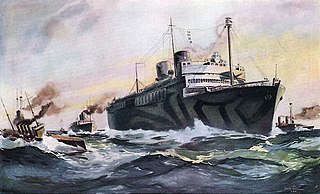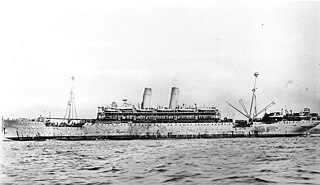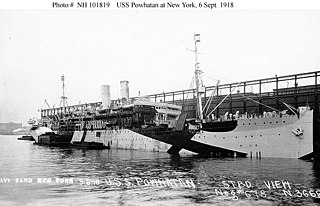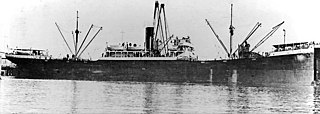This article needs additional citations for verification .(February 2022) |
The American Black Sea Line was a shipping company based in the United States which operated from 1921 until 1923.
This article needs additional citations for verification .(February 2022) |
The American Black Sea Line was a shipping company based in the United States which operated from 1921 until 1923.
The company was founded in 1921 by Stephen D. Stephendis. [1]
The company started when Stephen D. Stephendis bought the Kilpatrick from the U.S. government. He rebuilt the ship, added a second funnel and renamed it the Acropolis. It was sold in 1923 to the Booras Brothers. The second ship, the New York, was chartered from the Irish American Line in 1922 and sailed only once for Stephendis from New York to Constantinople before being sold by auction. [2]
Its fleet included:
Holland America Line N.V. (HAL) is an American-owned cruise line, a subsidiary of Carnival Corporation & plc headquartered in Seattle, Washington, United States.

USS Pocahontas (SP-3044) was a transport ship for the United States Navy during World War I. She was originally SS Prinzess Irene, a Barbarossa-class ocean liner built in 1899 by AG Vulcan Stettin of Stettin, Germany, for the North German Lloyd line.

America was a 19th-century racing yacht and first winner of the America's Cup international sailing trophy.

Hammac was a steam tank ship built in 1920–1921 by Bethlehem Shipbuilding Corporation of Alameda for the United States Shipping Board as part of the wartime shipbuilding program of the Emergency Fleet Corporation (EFC) to restore the nation's Merchant Marine. Early in 1923 the vessel together with two other tankers was sold to General Petroleum Corporation and renamed Emidio. The tanker spent the vast majority of her career carrying oil along the West Coast of the United States as well as between West and East coast. In December 1941 she was shelled and damaged by the Japanese submarine I-17 and eventually wrecked with a loss of five crewmen.

City of New York was a British built passenger liner that was designed to be the largest and fastest liner on the Atlantic. When she entered service with the Inman Line in August 1888, she was the first twin screw express liner in the world, and while she did not achieve the westbound Blue Riband, she ultimately held the eastbound record from August 1892 to May 1893 at a speed of 20.11 knots. City of New York and her sister City of Paris are considered especially beautiful ships, and throughout their careers were rivals to White Star Line's Teutonic and Majestic. In February 1893, the Inman Line was merged into the American Line and, by act of Congress, the renamed New York was transferred to the US flag. Beginning in the mid-1890s, New York and Paris were paired with St Louis and St Paul to form one of the premier Atlantic services. New York continued with the American Line until 1920 and was broken for scrap in 1923. She served in the United States Navy as USS Harvard during the Spanish–American War, and Plattsburg in World War I. She is also remembered for nearly colliding with RMS Titanic as the latter ship departed on her maiden voyage in 1912.

USS Siboney (ID-2999) was a United States Navy troopship in World War I. She was the sister ship of USS Orizaba (ID-1536). Launched as SS Oriente, she was soon renamed after Siboney, Cuba, a landing site of United States forces during the Spanish–American War. After her navy service ended, she was SS Siboney for the New York & Cuba Mail Steamship Co.. The ship was operated under charter by American Export Lines beginning in late 1940. During World War II she served the U.S. Army as transport USAT Siboney and as hospital ship USAHS Charles A. Stafford.

Great Northern was a passenger ship built at Philadelphia by William Cramp & Sons under supervision of the Great Northern Pacific Steam Ship Company for the Spokane, Portland and Seattle Railway Company, itself a joint venture of the Great Northern Railway and Northern Pacific Railway. Great Northern, along with sister ship Northern Pacific, were built to provide a passenger and freight link by sea between the northern transcontinental rail lines via the Spokane, Portland and Seattle Railway terminal at Astoria, Oregon and San Francisco beginning in spring of 1915.

USS Princess Matoika (ID-2290) was a transport ship for the United States Navy during World War I. Before the war, she was a Barbarossa-class ocean liner that sailed as SS Kiautschou for the Hamburg America Line and as SS Princess Alice for North German Lloyd. After the war she served as the United States Army transport ship USAT Princess Matoika. In post-war civilian service she was SS Princess Matoika until 1922, SS President Arthur until 1927, and SS City of Honolulu until she was scrapped in 1933.

RMS Empress of Scotland, originally SS Kaiserin Auguste Victoria, was an ocean liner built in 1905–1906 by Vulcan AG shipyard in Stettin for the Hamburg America Line. The ship regularly sailed between Hamburg and New York City until the outbreak of war in Europe in 1914. At the end of hostilities, re-flagged as USS Kaiserin Auguste Victoria, she transported American troops from Europe to the United States. For a brief time Cunard sailed the re-flagged ship between Liverpool and New York.

SS Prinz Friedrich Wilhelm was an ocean liner for North German Lloyd (NDL) from her launch in 1907 until the end of World War I. After the war, she briefly served as USS Prinz Friedrich Wilhelm (ID-4063) for the United States Navy returning American troops from France. The vessel was first chartered—and later purchased outright—by Canadian Pacific Steamships (CP) and operated under the names Empress of China, Empress of India, Montlaurier, Monteith, and Montnairn. She was scrapped in 1929.

USS Powhatan (ID–3013) was a transport ship for the United States Navy during World War I. She was originally Hamburg, a Barbarossa-class ocean liner built in 1899 by AG Vulkan of Stettin, Germany, for the Hamburg America Line. At the outset of World War I the ship was interned by the United States.

The Los Angeles Steamship Company or LASSCO was a passenger and freight shipping company based in Los Angeles, California.

SS Black Osprey was a cargo ship for the American Diamond Lines and the British Cairn Line. She was formerly known as SS West Arrow when she was launched for the United States Shipping Board (USSB) during World War I. The ship was inspected by the United States Navy for possible use as USS West Arrow (ID-2585) but was neither taken into the Navy nor ever commissioned under that name.

USS West Carnifax (ID-3812) was a cargo ship in the United States Navy shortly after World War I. After she was decommissioned from the Navy, the ship was known as SS West Carnifax, SS Exford, and SS Pan Royal in civilian service under American registry.
West Cawthon was a steam cargo ship built in 1919 by Southwestern Shipbuilding Co. of San Pedro for the United States Shipping Board (USSB) as part of the wartime shipbuilding program of the Emergency Fleet Corporation (EFC) to restore the nation's Merchant Marine. Initially, the vessel was placed in the Pacific trade, but was soon acquired by the Green Star Steamship Co. and was put on the Gulf to the Mediterranean route. In 1923 Green Star Steamship Co. went bankrupt and vessel was bought back by USSB. The freighter then spent next two years serving the Mediterranean ports of Italy and Spain before being laid up late in 1924. In 1926 the vessel was bought by the American-South African Line and for the next fourteen years continuously sailed between the East Coast of the United States and South Africa. In 1940 she was sold to the Ministry of War Transport (MoWT) and renamed Empire Bison. The ship was torpedoed and sunk by German submarine U-124 on 1 November 1940 on one of her regular convoy trips.

Evan Thomas, Radcliffe and Company was one of the more prosperous and better-known of Cardiff-based shipowning companies, established in 1882 by a Ceredigion sea captain, Evan Thomas, and a Merthyr Tydfil businessman, Henry Radcliffe. Until 1939 one of the main trades of the company was to carry Welsh steam coal, which reached its peak in the years immediately before World War I. The company was ceased trading in the 1980s.

Corvus was a steam cargo ship built in 1919 by Columbia River Shipbuilding Company of Portland for the United States Shipping Board as part of the wartime shipbuilding program of the Emergency Fleet Corporation (EFC) to restore the nation's Merchant Marine. The freighter was operated on international and domestic routes through 1944. Early in 1945 she was transferred to Soviet Union as part of lend-lease program and renamed Uzbekistan. After several months of operation, the freighter was rammed by another vessel on 31 May 1945 and was beached to avoid sinking. She was subsequently raised and towed to Portland where she was scrapped in 1946.

Wolverine State was a steam passenger-cargo ship built in 1919–1920 by New York Shipbuilding Company of Camden for the United States Shipping Board (USSB) as part of the wartime shipbuilding program of the Emergency Fleet Corporation (EFC) to restore the nation's Merchant Marine. The ship was initially employed on the United States to India route until its cancellation in Spring 1922. After remodeling the vessel was briefly used by the Los Angeles Steamship Company on a run between Los Angeles and Honolulu as an emergency replacement for one of their burned out steamers. In April 1922 the steamer was renamed President Harrison. In 1923 she conducted several trips between California and the east coast of South America, before being sold together with several other ships of her class to the Dollar Steamship Company. The vessel was captured in 1941 by the Japanese after she was deliberately run aground to avoid the capture. After repairs, the ship was renamed Kachidoki Maru (勝鬨丸), put under control of NYK Line and entered the Japan to Taiwan route, but soon after was requisitioned by the Imperial Japanese Army. Under IJA control the ship sailed between Japan, Singapore and the Philippines carrying troops and military supplies. She was torpedoed and sunk on 12 September 1944 on one of her regular trips, while carrying 950 Allied prisoners of war of which 431 were killed.

Missourian was an early American motor cargo ship which was built in 1921 in Chester, Pennsylvania, for the American-Hawaiian Steamship Company. She was sold to the British Ministry of War Transport in 1940 and renamed Empire Swan. Transferred to the Belgian government in 1942, she was renamed Belgian Freighter. She was sold to the Compagnie Maritime Belge in 1946 and renamed Capitaine Potié.

Californian was an early American motor cargo ship which was built in 1921 in Chester, Pennsylvania for the American-Hawaiian Steamship Company. She was sold to the British Ministry of War Transport in 1940 and renamed Empire Kite, and renamed Empire Seal later that year. She was torpedoed and sunk in February 1942.